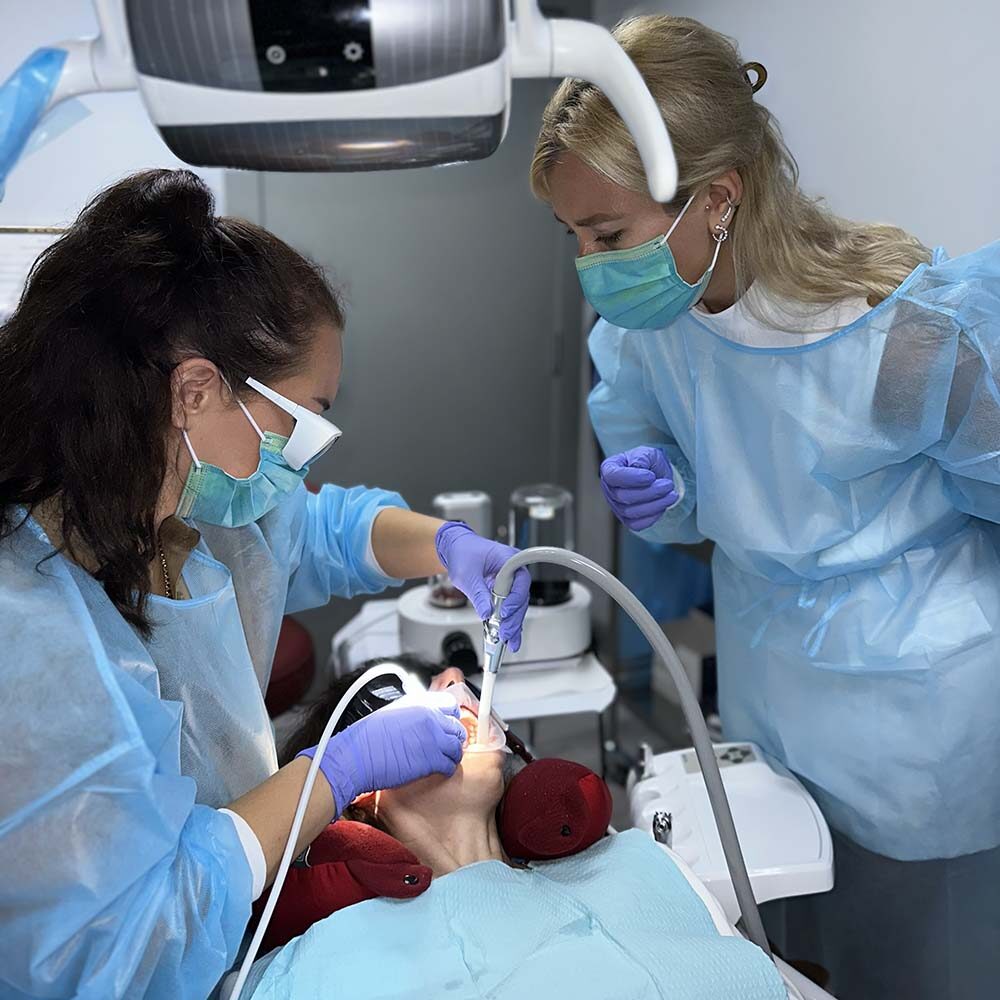Discover the beneficial effects of teeth cleaning with the use of Air Flow technology at Solea Dental. We effectively remove stains, plaque, and tartar, revealing your natural and healthy smile.
We use advanced technologies that restore the health of your entire oral cavity. Schedule an appointment today to experience all the benefits of Air Flow.
Why do patients choose us?
Our experienced and meticulous hygienist will perform the teeth cleaning in the safest and most painless way possible. The procedure is carried out using modern and high-tech equipment - EMS- Prophylaxis Master. In just 30–40 minutes, your teeth will be clean and smooth.
Special Offer
| Procedure | Cost |
|---|---|
| Air Flow cleaning + Dental consultation + X-ray Panoramic Exam and get a Whitening as a gift | $199 |
| Air Flow cleaning + Dental consultation + X-ray Panoramic Exam | $149 |
Reviews from our patients
Is it suitable for me?
We recommend Air Flow to:
Anyone who wants a thorough tooth cleaning to maintain oral health.
Patients with plaque buildup in gum pockets, on teeth, and between them.
Individuals with mild to moderate gingivitis as part of comprehensive dental care.
Those with orthodontic braces for cleaning around brackets, especially in hard-to-reach areas.
Patients with implants or crowns to maintain the longevity and aesthetics of their dental restorations.
Smokers to remove stubborn tobacco stains.
Coffee, tea, or wine lovers to eliminate tooth discoloration.
People with sensitive teeth, since Air flow is a gentle and non-abrasive technology.

Why should you not postpone professional teeth cleaning?
To prevent the development of cavities, gum diseases, and to eliminate unpleasant bad breath.
How does it work?
The Air flow technique operates on the principle of sandblasting. A fine powder, called Plus, is used to painlessly remove dental plaque without harming the enamel and gum tissues. It is delivered along with compressed air and water.
If it is necessary to treat the subgingival area (in the presence of periodontal pockets), a special PerioFlow tip is used.
Advantages of this technique
- Fast
The procedure takes 30–40 minutes.
- Painless
In 99% of cases, there is no discomfort or pain.
- Safe
Dental enamel and gums remain undamaged. It does not cause allergic reactions.
- Beneficial
Disinfects the oral cavity, eliminates bad breath, and helps prevent dental diseases.
- Important
Helps remove plaque in hard-to-reach areas and keeps the enamel smooth, preventing bacteria from clinging to it.
Are there any drawbacks to Air flow? Yes, one limitation is that it cannot effectively remove hard tartar.
Contraindications
- The procedure cannot be performed in the following cases:
- When gums are bleeding or inflamed.
- In the presence of hard tartar.
- For individuals with bronchial asthma (requires additional specialist consultation).
- During pregnancy and breastfeeding.
Air flow and ultrasonic cleaning are procedures that serve different purposes, but both are part of professional oral hygiene.
How do they differ? Air flow removes only soft dental deposits, while ultrasonic cleaning effectively deals with hard tartar.
How do they work together? If dental tartar is detected during the examination, ultrasonic cleaning is performed first, followed by the use of Air Flow..
Stages of Procedure
Examination
The dentist assesses the condition of the teeth and gums and rules out any contraindications.
Preparation
The patient puts on protective eyewear and a special gown (to shield from airborne particles). If necessary, a local anesthetic spray is applied to the gums. In some cases, the dentist may also apply an indicator substance to the tooth enamel (to identify areas of plaque buildup).
Cleaning
For 30–40 minutes, the hygienist removes soft deposits, thoroughly cleaning each tooth and the spaces between them.
Final Steps
Optionally, enamel mineralization may be performed as prescribed by the dentist. The specialist provides guidance on oral care.
Dr. B. Lipovetskiy
EMS-Airflow Prophylaxis Master
This is an innovative and unique equipment from EMS company that takes cavity treatment and periodontal disease prevention to a whole new level.
Questions and Answers
The procedure is minimally invasive, especially when compared to mechanical or ultrasonic cleaning. If the patient experiences slight discomfort, it can be alleviated with a local anesthetic.
Since it is part of the comprehensive oral hygiene routine, on average, it is repeated every 3-4 months. However, if the patient has no dental issues and follows all the dentist's recommendations, a follow-up visit is possible after a year.
- Refrain from eating for 2 hours after the cleaning. Then, consume soft foods to avoid gum irritation.
- Avoid smoking, coffee, or other staining beverages/foods for the first 3-4 hours.
- Postpone tooth brushing for a day, and replace your toothbrush with a new one. You may use mouthwash as directed.
Some worry that using baking soda may negatively affect the condition of the enamel and gums. However, this is not the case. The cleaning process involves using granules of a safe size that do not scratch the enamel or gums.



